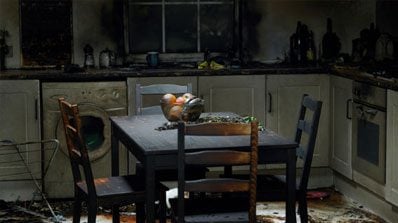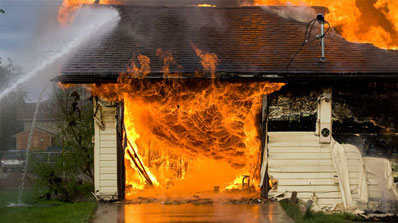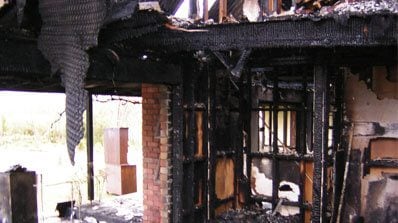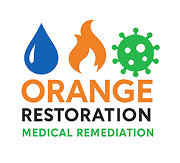
Fire Damage Restoration Processes and Procedures
Experiencing the aftermath of a fire is an overwhelming disaster. No one should have to endure this alone. Handling fire damage requires expertise, and in most cases, fire and smoke damage should be addressed by trained fire remediation professionals to ensure safety and efficiency. Let’s discuss knowledge on fire damage and how to rebuild after fire damage one stage at a time.
Restoration After Fire and the After Fire Cleanup
After fire cleanup is no job for the average homeowner. Fire crews have used water, but when they run out of water like in the recent LA Fires, firefighters use specialized foam. This foam is highly toxic PFAS (or per- and polyfluoroalkyl substances) are known as” forever chemicals” and should be handled by professionals with the right gear for protection. For the clean up of the recent fires in Pacific Palisades and Studio city, the firefighting foam will be needed to be properly remediated by professionals.
How Do I Address Water and Moisture Problems Following a House Fire?
Water is the unlikely villain that lingers long after the flames are out. Between fire hoses and firefighting foam (hello, PFAS), your home may look less like a home and more like a soggy, toxic sponge. But before you start channeling your inner lifeguard, it’s crucial to tackle water and moisture swiftly—otherwise, you could end up with an unwanted science experiment in mold and mildew.
Here’s how to proceed without making things worse:
- Extract Standing Water ASAP: Use wet vacs, industrial pumps, or trusted water extraction services. Don’t delay: even clean-looking areas can trap moisture.
- Thorough Drying: Industrial-strength dehumidifiers and high-powered fans are a must. Crack open windows if the air outside is dry, and keep ventilation steady to fend off mold spores looking for a dance floor.
- Hunt Down Hidden Moisture: Moisture doesn’t just sit in plain sight. Use moisture meters and infrared cameras to sniff out dampness hiding in walls, insulation, or under floors. Professional teams come equipped with these gadgets.
- Remove Water-Damaged Materials: Soggy drywall, insulation, and carpeting are breeding grounds for mold and should be removed and properly disposed of. Don’t risk a DIY patch job—replace those compromised materials entirely.
- Monitor and Prevent Mold: Mold begins growing in as little as 24-48 hours. Watch for musty odors or visible spots. If in doubt, call a certified mold remediation specialist, Pacific Palisades and Studio City residents know this story all too well after the last round of fires.
Remember, acting fast is your best defense against long-term water-related headaches. Next, let’s look at some of the surprising hazards that lurk in a home’s aftermath after a fire…
How Can I Prevent Mold Growth After a Fire?
Firefighters work swiftly to save structures, but their efforts often leave behind more than just charred remains—soaked floors, drenched walls, and pockets of hidden moisture present a brewing ground for mold. Even after the flames are gone, stopping mold in its tracks is crucial for your health and home.
Here’s what to do next:
- Act Fast: Mold can begin growing within 24-48 hours after fire crews douse the last sparks. Time is not on your side.
- Remove Standing Water: Use wet vacuums or pumps to clear pools of water from any affected area.
- Dry Everything Thoroughly: Open windows, bring in industrial fans, and run dehumidifiers. Focus on drywall, insulation, flooring, and any porous surfaces.
- Pull Out Wet Materials: If floors, drywall, or insulation are saturated, they’re at risk for mold. Remove and discard any material that can’t be completely dried.
- Check Hidden Spaces: Moisture loves to hide behind walls, under carpets, or inside cabinets. Consider thermal imaging cameras or moisture meters—tools often used by restoration specialists—to detect tricky damp spots.
- Sanitize Affected Areas: Scrub any surfaces touched by firewater with antimicrobial cleaners or diluted bleach, wearing gloves and a mask for protection.
The key? Act like you’re racing the clock. By minimizing moisture and eliminating the conditions mold loves, you’re not only protecting your home, but also the health and well-being of everyone inside.
How Can I Implement Fire Prevention and Protection Measures in My Home?
Fire prevention starts long before disaster strikes. Whether you’re repairing fire damage in San Diego, SoCal, or preparing your home elsewhere, being proactive is your best line of defense. Here’s how you can level up your home’s fire safety:
- Upgrade electrical systems: Outdated wiring is a leading cause of house fires. Consider having a licensed electrician assess and upgrade old panels, faulty outlets, or overloaded circuits.
- Install smoke alarms and test them frequently: Every floor and sleeping area should have a smoke alarm. Change batteries twice a year—perhaps every time you change the clocks.
- Use fire extinguishers and teach household members how to use them: Place extinguishers in high-risk areas like kitchens and garages. The PASS method (Pull, Aim, Squeeze, Sweep) is key—make sure everyone knows it.
- Add fire sprinklers if possible: Residential sprinklers provide invaluable protection and can often douse flames before firefighters even arrive.
- Maintain clutter-free exit routes and create an evacuation plan: Keep hallways clear and practice your family escape plan at least twice a year.
- Be mindful with heat and open flames: Never leave candles, space heaters, or stovetops unattended. Store flammables safely away from heat sources.
By embracing these fire prevention and protection strategies, you’ll help safeguard your home and loved ones from future fires, adding another vital layer to your recovery and resilience strategy.
What Unexpected Hazards Exist in Fire Aftermath?
As mentioned, chemicals and threats to your respiratory system are greatly increased due to chemicals from the home burning and the PFAS left from fire crews.
In the case that your home has burned without fire crew intervention, the home is still not the safe space it once was before the fire. In many cases, after a fire there is water damage, unstable structures, falling debris, exposed nails, carcinogenic chemicals in air, and even risk of electronic shock. Once solid boards can crush under pressure, allowing nails to protrude and go through soles of shoes. Do not enter a fire site without permission from fire site professionals, a site guide to accompany you, and safety gear.

What is the Meaning of Fire Damage Remediation?
Fire damage remediation refers to the critical cleanup work that occurs after a fire and before rebuilding or restoration efforts begin. It involves removing charred materials, soot damage, destroyed furnishings, and cutting out damaged framework. This process also includes cleaning up the aftermath left by fire crews, such as water damage from extinguishing efforts. Fire damage remediation does not cover the rebuild after fire damage but the removal of the damage and hazards.
Fire Remediation VS Fire Restoration Service
While many might assume fire remediation companies handle rebuilding, only fire restoration companies, like Orange Restoration, offer reconstruction services. With over 20 years of experience managing extensive fire damage restoration projects, Orange Restoration provides comprehensive solutions. We have an entire team of professionals to help including an in-house master plumber, electricians, water damage remediation specialists, mold specialists, and reconstruction team.
Our added benefits include our experience with Medically Sound Remediation and Small Particle Cleaning. We have experience in handling indoor air contamination, smoke damaged or odor problems, and working with CIRS patients to remove ultrafine particles from home air environments.
We care about your health! Often while we are not working on medical projects we still use our experience to help homeowners with health related concerns.

Meet Our Qualified Restoration Experts
Our reputation is built not just on our years of experience, but on the depth and diversity of our team’s expertise. Each member brings specialized skills and certifications that ensure every project is handled with care and precision:
- Certified Construction Managers: With decades of hands-on experience in both residential and commercial restoration, our management team oversees every phase, from initial assessment to final walkthrough.
- OSHA-Trained Technicians: Safety is our top priority. Our technicians hold OSHA certifications and undergo regular training on the latest restoration and safety protocols.
- Specialists in Water, Fire & Smoke Restoration: We employ IICRC-certified professionals, including Water Damage Restoration Technicians (WRT), Fire & Smoke Restoration Technicians (FSRT), and Odor Control Technicians (OCT), ensuring your property is restored to the highest standards.
- Advanced Planning & Scheduling: Leveraging tools like Microsoft Projects, our team is equipped to manage complex timelines while keeping you informed throughout the process.
- Environmental & Health Experts: Our lead and asbestos supervisors are certified to address hazardous materials, while our medically sound remediation specialists are trained to work with sensitive cases, including those involving chronic inflammatory response syndrome (CIRS).
Whether your restoration project requires advanced structural repairs, meticulous odor removal, or specialized cleaning for sensitive health needs, our team’s credentials and experience mean you’re in trusted hands.
We care about your health! Often while we are not working on medical projects we still use our experience to help homeowners with health related concerns.
What Certifications Should I Look For When Hiring Fire Restoration Professionals?
When it comes to choosing the right team to help restore your home after a fire, certifications matter a lot!!! You want to ensure you’re working with professionals who not only talk the talk, but have walked the walk through rigorous standards and training.
Look for fire restoration specialists who are licensed, bonded, and insured, of course. But go a step further and check for certification from the Institute of Inspection, Cleaning and Restoration Certification (IICRC), the gold standard in fire and water restoration. The IICRC sets industry benchmarks and requires technicians to undertake thorough training, proving both their expertise and commitment to quality.
Why does this matter? Because working with IICRC-certified pros means your home is in hands that understand the latest techniques, codes, and health guidelines, including handling of hazardous residues like PFAS, smoke particulates, and water damage. An IICRC certification also signals compliance with the American National Standards Institute (ANSI) standards, ensuring attention to both safety and quality workmanship.
If you want peace of mind, always ask potential restoration companies about their certifications, and request to see documentation. Certification isn’t just a plaque on the wall; it’s a promise of professionalism, knowledge, and care for your home and well-being.
Typical Backgrounds and Roles of Project Managers and Construction Managers in Restoration
When disaster strikes, a skilled project manager or construction manager is the unsung hero behind the scenes, carefully shepherding every step of the restoration journey. But what exactly do these experts bring to the table, and what can you expect from their involvement in fire damage or reconstruction projects?
A Diverse Set of Skills and Certifications
Most project managers and construction managers in restoration come armed with an impressive arsenal of experience, education, and certifications. Their backgrounds often include:
- Years in Construction & Insurance Restoration: Many have decades-long careers with a blend of general construction experience and specialized work in insurance restoration, giving them vital insight into both the hands-on and logistical aspects of recovery.
- Relevant Certifications: Common industry-standard credentials include IICRC certifications (such as Fire & Smoke Restoration Technician, Water Damage Restoration Technician, and Odor Control Technician), OSHA safety training, and certificates in lead and asbestos management. Some may even hold advanced certifications like HAAG Residential Roofing or specialized credentials in mold assessment.
- Formal Education: Degrees in construction management, business administration, or related technical fields are frequent, often combined with practical training in planning, estimation, and project oversight.
What They Actually Do
These professionals manage the entire restoration and rebuilding process after a fire, working as the conductor for a symphony of trades and specialists. Typical responsibilities include:
- Project Planning & Estimation: Creating detailed, accurate estimates reflecting the true scope of damage, which is critical for both insurance claims and ensuring all necessary repairs are covered.
- Coordination & Communication: Acting as the main point of contact, they keep homeowners informed, patiently guiding them through the insurance process and clarifying complex topics.
- Safety Oversight: Ensuring all work meets OSHA and EPA safety standards, including the use of protective gear and adherence to safe practices regarding toxins like lead, asbestos, or PFAS contamination.
- Problem-Solving: Using their expertise to anticipate challenges, from water damage remediation to structural rebuilds, and developing creative solutions to keep the project moving.
- On-Site Supervision: Overseeing the work of specialized restoration teams, plumbers, electricians, HVAC techs, and carpenters, to guarantee high-quality results from demolition to rebuilding.
- Homeowner Support: Serving as a steady, empathetic presence for families during stressful times, providing reassurance, and striving to exceed expectations in the final restoration.
The best project managers in restoration not only bring technical know-how but also a commitment to helping homeowners safely and confidently reclaim their living spaces.
How Long After a Fire Can You Go Back?
We very much empathize with the want to return your home to normal as soon as possible. First, safety must be the top priority after a fire. Returning to a fire-damaged property is not recommended until it has been deemed safe by professionals.
Fire damage compromises structural integrity, and the environment may contain harmful toxins or unstable areas.
Reputable fire damage restoration companies may allow supervised visits as progress is made, but proper personal protective equipment (PPE) must always be used. Always consult professionals before accessing a fire site and ensure your visit is necessary and safe.

How Do You Restore and Rebuild After Fire Damage?
Restoring a home after fire damage involves careful planning and expert guidance. Below are the key steps in the fire damage restoration process:
- Prioritize Safety: We can’t say it enough, avoid entering the property until professionals confirm it is safe.
- Handle Insurance Claims: Work with your insurance agent to document damages, discuss claims, and select a reputable restoration contractor like Orange Restoration.
Why a Knowledgeable Project Manager Makes All the Difference
Navigating the insurance process after a fire can be overwhelming and confusing, especially when you’re already dealing with the emotional toll of property loss. This is where having a project manager with real expertise becomes invaluable.
Here’s how a seasoned project manager supports you after a fire:
- Expert Guidance: Their experience in fire restoration and industry certifications, such as FSRT (Fire & Smoke Restoration Technician) or OCT (Odor Control Technician), mean they understand exactly what your insurance provider needs for a smooth claim.
- Clear Communication: They break down complex insurance language, helping you understand your policy, the required documentation, and your eligible coverage, so you aren’t left in the dark.
- Streamlined Claim Process: With a dedicated specialist, you’ll stay organized when collecting photos, invoices, and evidence to support your claim. This can help avoid costly mistakes or overlooked details.
- Advocacy: A knowledgeable project manager represents your best interests, ensuring no damage is missed and advocating for comprehensive repairs, not just cosmetic fixes.
- Peace of Mind: Most importantly, they act as a calm, reassuring point of contact, answering your questions and helping you make informed decisions every step of the way.
Partnering with restoration professionals who offer project management ensures you have someone in your corner, ready to guide you through each twist and turn of the insurance maze, so you can focus on what matters most: getting your home and your life back on track.
3. Hire a Fire Damage Restoration Expert: Promptly contact professionals to assess the damage and outline a plan. Make sure to get a start date and ask for a clear outline of expectation on the process.
4. Assess the Extent of Damage: Professionals will inspect the structural elements and systems, such as load-bearing walls, beams, and HVAC systems.
5. Secure Your Property: Board up windows, doors, and other access points to prevent vandalism or further damage. Some companies offer emergency board up services.
6. Structural Repairs: Replace damaged components such as joists, beams, and columns.
7. Electrical System Repair: Before new structures, walls, and appliances can be installed to your home, restoring your utility systems is necessary. The electrical system is particularly susceptible to fire damage. It must be thoroughly inspected, and any damaged components replaced. Have a licensed electrician inspect and restore your home’s electrical system, including notifying SDG&E for reconnection after a fire shutoff.
8. Address Fire-Specific Damage: Remove soot, smoke stains, and clean air ducts to restore indoor air quality.
9. Restore Room by Room: Tackle restoration systematically, one room at a time.
10. Document Everything: Keep records of all repairs, invoices, and professional communications for insurance purposes. Digitalize these records to create a comprehensive folder that can serve as evidence of the extent of the damages, the resources expended, and the professionals involved.
11. Plan for Costs: Fire restoration costs vary widely; ensure your insurance and budget account for rebuilding needs. Be prepared for these costs and explore insurance options if you reside in areas prone to wildfires. Also, when discussing the rebuild, if you want modifications to the way things were before, let your builder know, you may need to pay out of pocket to do this, but some changes are worth it.
What is the Best Cleaner for Fire Damage?
For soot and charred stains, products containing trisodium phosphate (TSP) are highly effective. However, TSP is caustic and requires proper safety equipment. Always follow product instructions, test on inconspicuous areas first, and consult professionals for more severe damage.

Often if cabinets were fire adjacent they will have smoke damage and need to be thrown out or may require some real elbow grease in the fire damage restoration process.
Items exposed to heavy smoke, such as cabinets or furniture, may require significant cleaning or disposal as part of the restoration process.
What Should I Throw Away After Smoke Damage?
Anything easily replaceable, especially perishable food items, should be discarded. For anything structural, if we can rebuild after fire damage, it is better to do that than to try to save compromised structural joists or important beams that need more work than the cost of repairing with new. Consult fire remediation experts to determine what can be salvaged. Professionals can also evaluate whether belongings affected by smoke and fire exposure are safe to keep or require restoration.
What Happens if You Don’t Rebuild After Fire Damage?
Homeowners are not obligated to rebuild after a fire. Some may choose to take the insurance payout and start fresh elsewhere. However, others might opt to sell the property as-is. It’s essential to weigh the emotional and financial costs of rebuilding versus relocating.
Addressing and Rebuild After Fire Damage in Los Angeles
We feel empathy for the people of LA who have lost their homes or have had fire damages. With the increase in fire disasters in Los Angeles, such as the Hollywood Hills Fires and Studio City fires, more are seeking advice in fire prevention and aide in rebuild after fire damage that di not completely destroy their homes. Air quality and indoor air testing work is becoming more common as we have expanded our Medically Sound Remediation services to Orange County.
These fires often leave behind hazardous soot and toxins that require specialized cleanup to ensure the safety of residents. From addressing structural damage to improving indoor air quality, our team ensures that properties are restored to a safe and habitable condition. If your home was lost in the LA Fires, please contact us for support or questions related to insurance or fire restoration.
Orange Wrap-Up
The process to rebuild after fire damage or total loss is a complex process requiring careful planning, professional expertise, and a focus on safety. While each restoration project is unique, partnering with experienced professionals like Orange Restoration ensures that the process is handled efficiently and thoroughly. Whether in Los Angeles, Orange County, or beyond, we are here to help you rebuild and look forward to a safer, brighter future.
Master Guide On Tips to Rebuild After Fire Damage Blog Topics
- Fire Damage Remediation
- Critical 1st Steps to Restore after Fire Damage (read this to learn about rapid rebuild after fire damage)
- Clean Soot Char Yourself (DIY)
- Urgent Fire Damage Repairs and Medically Sound Remediation Concerns
- Negative Effects of Smoke and Fire Damage
- Electrical Fire Damage
- Cooking Tips to Prevent Kitchen Fires
If you need advice or support on your fire restoration project, give us a call today! (619) 376-6838
